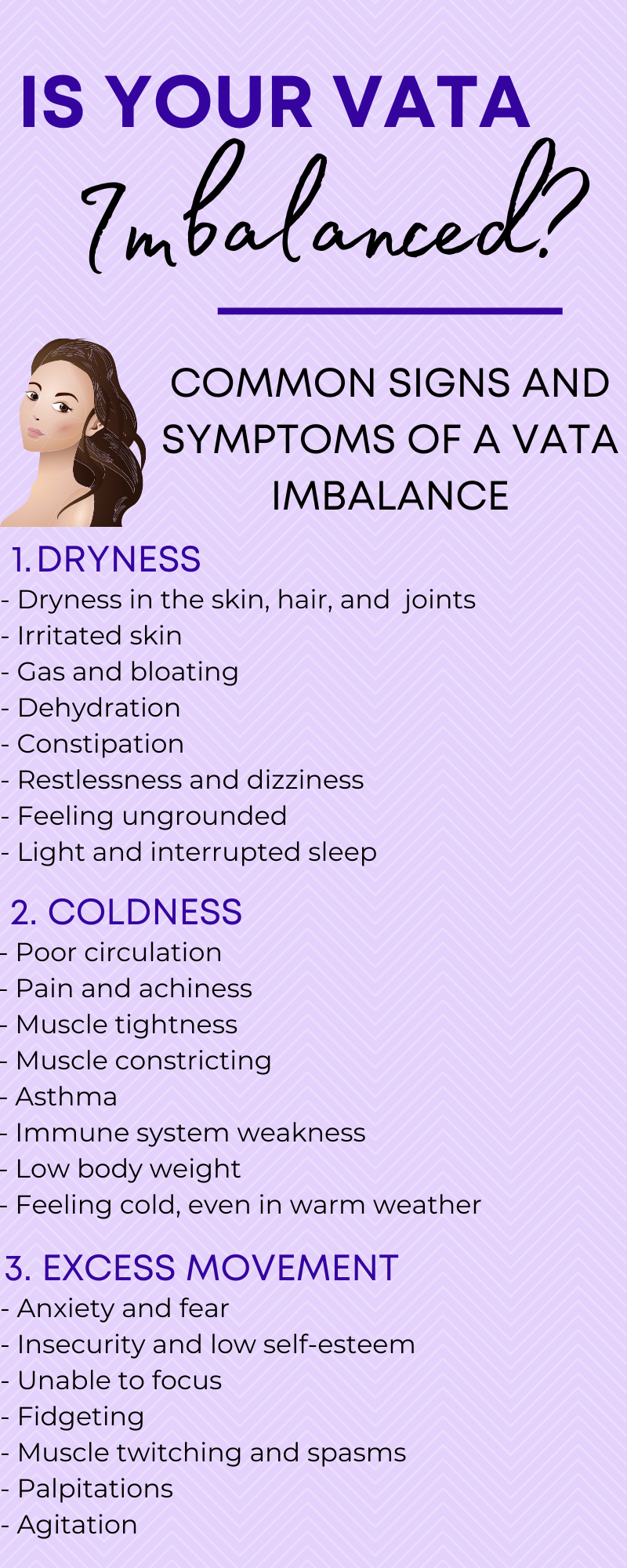About a month after transitioning to an ayurvedic lifestyle, I had a Vata imbalance.
Before discovering Ayurveda, I looked at constipation, bloating, anxiety, racing thoughts, and aching as symptoms that were caused by random choices I made.
Like the choice to eat too much fried food or not drinking enough water.
And while those symptoms certainly do stem from poor health choices, I never knew I could be experiencing them because one of my elements were knocked out of balance.
If your most dominant dosha is Vata, then Vata imbalances are something you must be wary of.
Although it’s known as “king of the doshas,” Vata energy can still become excessive.
Luckily, I came to the realization that what I was experiencing was, in fact, a Vata imbalance, and I was able to combat it quickly.
In this post, we’re diving deep into what a Vata imbalance looks and feels like along with eight treatments you can do at home to cure it. Plus, essential oils and ayurvedic herbs that pacify this chilling dosha king.
Disclaimer: This blog post contains affiliate links. I may earn a small commission to fund my essential oil shopping spree habits if you use these links to make a purchase. You will not be charged extra, and you’ll keep me supplied in good-smelling oils. It’s a win for everyone, really.

What Is Vata?
Before jumping into what a Vata imbalance is and how to fix it, we need to make sure we have a clear understanding of what the Vata dosha really is.
In Ayurveda, five elements compose nature—water, fire, earth, air, and space (also called ether).
Each of the three doshas—Vata, Pitta, and Kapha—are made of two primary elements. Vata’s composition is air and space.
Although as humans we’re comprised of primarily one or two doshas, we have varying amounts of all five elements in us.
So no one is ever just one dosha. That’s why I like saying Vata-dominant or Pitta-dominant rather than just Vata or Pitta when describing a person.
Basically, remember that even though your body’s composition is mostly Vata, Pitta and Kapha still live within you. And they have to be cared for, too.
The Vata dosha itself is characterized by mobility, coldness, lightness, and dryness.
Vata’s mobile and dynamic nature resembles the element of air, while its coldness and dryness resemble space.
The Vata dosha got its name from the Sanskrit word vayu, which means “wind.” There are five types of vayus, but prana vayu is known as “vital energy” in India and is similar to the Chinese qi. It’s the energy of life. It brings movement to life, and there must be movement for life to be present.
As a result, Vata is often considered the “king of doshas” because, without its movement, Pitta and Kapha wouldn’t be energized.
Vata Season
Since nature is comprised of the elements, it only makes sense that the seasons resemble their qualities.
Each season, one of the doshas becomes the most prominent. This also means that people whose body constitution is primarily that dosha run the risk of a dosha imbalance during that season.
The Vata season is late Autumn to early Winter.
This is because, in nature, Vata’s elements are cold, rough, and windy.
So if you’re a Vata-dominant person, be more alert of a Vata imbalance during this time of year, and take extra care that your body is being properly nurtured.
Key Characteristics of a Vata-dominant Person
To know what to look for in a Vata imbalance, you must first know what a balanced Vata dosha looks and feels like.
Let’s take a look at some of the key characteristics and qualities of a dominant Vata person. In other words, the characteristics the Vata embodies when balanced.
Keep in mind that even though your most dominant dosha might be Vata, your personality and physical traits won’t always be in perfect alignment with the list below.
Everyone’s different, and these lists are just a starting point. They introduce you to the most common, average signs of a Vata-dominant person.
The best way to determine whether or not your primary dosha is in fact Vata is to visit an ayurvedic doctor. But if that’s out of your budget or a few hundred miles too far, try taking a few dosha quizzes online.
Physical Characteristics of the Vata Dosha
- Slim build with long bones and ligaments, particularly in the arms and legs
- Very tall or very short
- Dark and thin hair, usually dry, curly, or kinky
- Thin, dry, cool, and somewhat dark skin
- Narrow, oval face with small eyes
Personality Traits of the Vata Dosha
- Actions and thoughts are quick
- Tend to multi-task
- Appetite and meals tend to be irregular
- Constipation is fairly common
- Sleep is light and prone to interruptions
- Vivid dreams full of movement
- Energy and activity come in bursts, whereas stamina is usually low
- Creative and expressive with lots of ideas
- Loves to travel, dance, and participate in creative or art activities
7 Tell-All Signs and Symptoms of a Vata Imbalance
When Vata is out of balance, it’s irregular.
This irregularity can cause internal symptoms—such as fear and anxiety—as well as physical symptoms.
If you aren’t sure whether you’re experiencing a Vata imbalance, heed these warning signs.

Dry Skin, Hair, and Joints
Dryness is one of Vata’s most prominent qualities. So when imbalanced, it often manifests as physical dryness.
A few common places dryness occurs during a Vata imbalance are:
- Ears
- Hair
- Lips
- Skin
- Joints
Perhaps you have eczema, and your eczema begins showing signs of irritation. Or your skin starts to peel, flake, or turn red and itchy.
And if you have to apply chapstick more than usual, your lips are likely suffering, too.
Gas, Bloating, Dehydration, and Constipation
These four nasty symptoms are also a result of Vata’s dry attributes. But rather than physical dryness, they represent internal dryness.
People with a Vata imbalance often suffer from one or more of these symptoms. The easiest way to combat them is by hydration and warming yourself up by increasing your agni (digestive fire). But we’ll get more into that when we talk about how to treat Vata imbalances.
Feeling Restless, Dizzy, and Ungrounded
Again, these signs stem from the dryness of Vata.
Restlessness, dizziness, and feeling ungrounded come from the mind being too dry and light. In fact, you might even describe these symptoms as feeling “light-headed.”
Poor Circulation, Pain, and Tightness
This time, we’re looking at how the Vata feels when it’s cold nature becomes a bit out of control.
Pain and aches are common symptoms of a Vata imbalance, as well as tightness. You might be feeling sore for no reason or achy without a fever.
When I went through my Vata imbalance, one of the first—and worse—symptoms I had was deep pain below my right shoulder blade. I even went to the doctor about it. My mom thought it was a result of me going vegan, but I was hoping it wasn’t.
It turns out, the doctor had no explanation for it other than possible scar tissue from my surgery two years prior. But after I realized it could’ve been a Vata imbalance and began treating it as such, the pain went away.
Other common symptoms are muscle spasms and constriction, asthma, and poor circulation.
Rough Skin and Lips
Remember when we talked about Vata’s elements in nature? They were cold, rough, and windy.
Consistent with Vata style, then, a tell-tale sign of Vata imbalance is roughness, especially on the skin and lips.
Anxiety, Fear, and the Inability to Focus
What makes Vata the “king of the doshas” is its movement because, without movement, life wouldn’t exist.
Well, when the Vata energy moves a little too much, it can be thrown out of balance. As a result, a Vata-dominant person will often experience fear, anxiety, racing thoughts, and the inability to focus.
Vatas are creative by nature. But when imbalanced, they often have too many ideas to act upon, or fear might keep them from it.
Fidgeting, Palpitations, Spasms, and Muscle Twitching
Excess movement can also manifest physically. It does so in the form of fidgeting, palpitation, and muscle twitching.
Spasms and twitching were big symptoms of mine when I experienced a Vata imbalance. Throughout the day, my muscles would spasm or twitch randomly.
How to Treat a Vata Imbalance: 8 Treatments You Can Do at Home
So, you have a Vata imbalance. Now what?
The different treatment methods and remedies are quite simple and easy to do. But before you dive in headfirst, it’s vital that you can answer this one question:
What makes these treatments so effective?
The simple answer: to balance the Vata dosha, you have to counter its qualities.
In other words, what’s in excess, you have to reduce.
The qualities of Vata are mobility, coldness, lightness, and dryness. So when one or more of these characteristics are excessive and have manifested as a Vata imbalance, you must counter them.
For example, if your Vata imbalance has manifested in feelings of constant coldness, you need to make yourself warm.
Pretty simple, right?
Now that you know the basics of bringing a Vata back to balance, let’s look at some foolproof ways to do so.
1. Hydrate
You probably noticed that many of the symptoms of an imbalanced Vata are due to the dosha’s dry nature. Dehydration and dry skin are just two of them.
To counter this and eventually bring Vata back to balance, we must reduce this excessive dryness.
And one of the best (and most obvious) ways to do that is by hydrating.
But before you begin gulping down a tall glass of ice water, keep in mind that Vata is also cold.
As a result, Vata-dominant people should favor room temperature or warm drinks, such as teas, warm milk, and water without ice. To give your drink even more warming qualities, add a lemon or herbs and oils that resemble warmth (we’ll talk about these later).
2. Abhyanga massage
One of the best ways to balance your Vata and hydrate your skin is to do an abhyanga self-massage.
To do an abhyanga massage, first, choose the oil you’re going to use. As a base, you’ll want to use either sesame or almond oil, but you can mix it with a Vata-pacifying essential oil. To learn what these oils are, scroll towards the end of the post.
After the oil is warm, begin to massage it into your scalp. Work your way down from your head to your toes, doing long, slow strokes on the limbs and circles on the joints.
Once you’re completely covered in warm oil, let it sit for 15 minutes. For that time, you can meditate, do yoga, dance, or do any other calming activity.
After the 15 minutes is up, take a shower or bath to rinse off the oil.
3. Adjust your diet
Vatas are irritated by foods that fall under the bitter, astringent, and pungent tastes. Do your best to reduce them, and favor sweet, sour, and salty foods.
If you aren’t familiar with the six tastes of Ayurveda, you might have trouble understanding that.
Basically, reduce the foods you eat that are dry, light, raw, processed, or cold.
Notice how I didn’t say completely cut them out. Since your body is composed of all three doshas, you need to nurture them all. Instead of cutting them out, eat them every once in a while and in small portions.
4. Stick to a consistent schedule
One of Vata’s most prominent characteristics is irregularity. So one of the most effective ways to balance Vata is by being regular.
Some examples of Vata’s irregular nature are that most Vata-dominant people are extremely tall or extremely short. Plus, they usually have low weight (often even underweight) and tend to gain and/or lose weight very rapidly.
Plus, Vatas have a bad habit of eating at irregular times. For instance, as a Vata, you might be starving on Monday, eat four meals, and then be barely hungry on Tuesday and only eat snacks throughout the day.
To combat this, start being more regular and consistent in all areas of your life.
For example:
- Eat 3 meals a day at the same time (for example, breakfast is always at 8 A.M.)
- Go to bed at the same time every night
- Wake up at the same time every morning
- Get enough sleep every night (ideally, get enough sleep between 10 P.M. and 4 A.M.)
- Exercise at the same time every day
5. Practice meditation and mindfulness
When the Vata is imbalanced, you often feel anxiety, fear, and/or racing thoughts. Meditation and mindfulness are the perfect remedies.
Meditation pulls you away from your external senses. As a result, your attention shifts from your physical body and the outside world to your internal self.
Mindfulness is a similar practice.
Many people mistake meditation and mindfulness as the same thing, but they’re a bit different. You can practice mindfulness without being in a meditative state, but you’re always mindful when meditating.
Mindfulness is a muscle that must be practiced, and meditation is one of the best ways to make it stronger.
You can be mindful throughout your daily life. And in fact, you should be. For example, you can be mindful when you eat by noticing how the food tastes, how it feels in your mouth, how it feels going down your throat, what it smells like, and how it’s shaped.
I highly prioritized eating with mindfulness during my transition to an ayurvedic lifestyle. Not only does it help you hone that muscle, but studies have shown that it also helps weight loss.
To learn more about the differences between mindfulness and meditation, check out this two-minute video by Ziva Meditation.
6. Enjoy sweet, soothing music and smells.
Not only does Vata favor the sweet taste, but also sweet atmospheres.
To calm your racing mind and pacify your Vata energy, create a zen and peaceful environment. Vata likes soothing smells and sounds, so creating an atmosphere that promotes tranquility is vital to bringing the dosha back to balance.
You can easily make a sweet and soothing scene by lighting candles with sweet scents, using oils that Vata favors, and listening to peaceful music.
Create a playlist on Spotify or Pandora of soothing sounds and play them in your room. Plus, diffuse Vata-pacifying essential oils, which we’ll take a look at later.
7. Use cooking oils that pacify Vata
Like essential oils, certain cooking oils pacify Vata energy. These oils are sesame oil, almond oil, and avocado oil.
When you cook with these oils, they internally warm your body and strengthen your agni (digestive fire). It’s also highly recommended to cook with ghee.
8. Use Herbs that Pacify Vata
Finally, our last step is to use herbs.
Certain herbs work wonders for treating Vata imbalances, just like oils. Like the oils, you can easily incorporate them into your daily life by cooking with them and drinking them.
For example, make chamomile tea to get your hydration in and your daily dose of Vata-reducing herbs.
To find a list of all the herbs Vata favors, see the last section of this post.
Essential Oils for Treating a Vata Imbalance
Essential oils work wonders for the mind and body.
Plus, they’ve been around since the ancient Egyptians in 4500 BC.
But when it comes to our doshas, do certain oils irritate them while others pacify them?
The short answer is yes.
Certain oils are ideal for Pittas and Kaphas, while others are more ideal for Vatas. This is because the oils Vata favors are sweet, soothing, and warm, balancing its qualities perfectly.
Let’s take a look at them now.
It’s best to mix these essential oils with sesame, ricin, or avocado oil as a base for maximum benefits.
Herbs and Remedies for Treating a Vata Imbalance
Last but not least, let’s discover some seemingly magical herbs that can help treat your Vata imbalance.
The reason these herbs are so effective is because they all increase your agni (digestive fire).
The good news is, these herbs are easy to incorporate into your everyday life.
You can brew them in your tea, cook with them, or add them to a warm glass of milk.
Of course, never use herbs unless you’re certain they’re safe for you to take. For instance, the herb ashwagandha is known to decrease fertility rates, while others don’t mix well with specific medical conditions.
It’s always wise to consult your doctor beforehand.
For more details on herbs, how to use them, their benefits, risks, and more, read our post on ayurvedic herbs here.
Now, let’s get into the best Vata-reducing herbs:
- Lehsun (garlic)
- Ginger
- Fennel
- Chamomile
- Dry basil
- Saraso seeds (mustard seeds)
- Poppy seeds
- Saffron (kesar)
- Ashwagandha
- Triphala
- Brahmi
And there you have it—the complete guide to curing your Vata imbalance!
The next time you have excess Vata, keep these signs and treatments in mind. Our doshas are beautiful—they’re part of what makes us who we are—so we need to nurture them properly.

